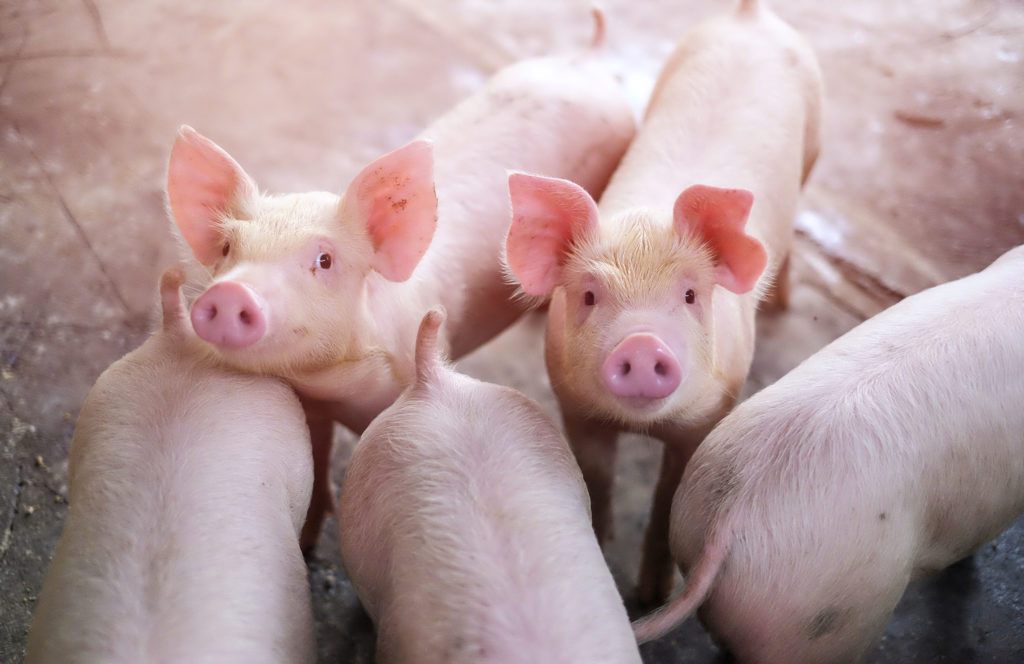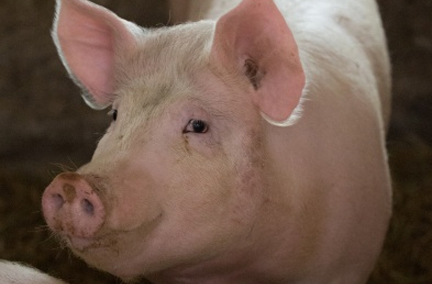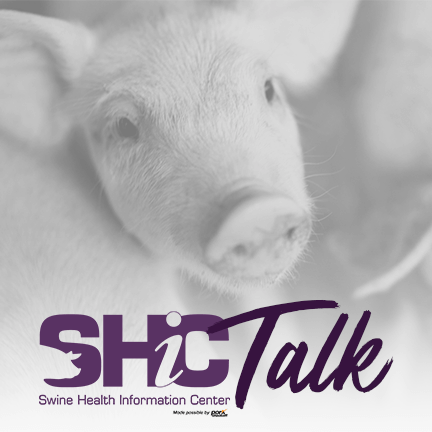
SHIC, launched by the National Pork Board in 2015 solely with Pork Checkoff funding, continues to focus efforts on prevention, preparedness, and response to novel and emerging swine disease for the benefit of US swine health. As a conduit of information and research, SHIC encourages sharing of its publications and research. Forward, reprint, and quote SHIC material freely. SHIC is funded by America’s pork producers to fulfill its mission to protect and enhance the health of the US swine herd. For more information, visit http://www.swinehealth.org or contact Dr. Sundberg at [email protected].

From its inception in 2015, the Pork Checkoff-funded Swine Health Information Center (SHIC) has been a leader in enabling research priorities to identify the risk and mitigation of feed ingredients as a route for introduction and transmission of swine diseases. Since 2016, SHIC has invested Checkoff-sourced resources in 20+ projects to conduct research geared at protecting the US swine herd from the risk of future disease threats through the route of feed and feed ingredients.
“Feed is a unique risk for swine diseases due to the global sourcing of ingredients and the direct access to pigs in high-biosecurity commercial operations,” said Dr. Megan Niederwerder, Associate Director of SHIC. “Learning from the introduction of porcine epidemic diarrhea virus (PEDV) in 2013, SHIC research investments have helped broaden our knowledge of feed risks for additional swine diseases of highest concern.”
Several important research objectives on understanding feed as a risk for swine diseases have been targeted and investigated through SHIC-funded projects and projects co-funded with other funding agencies, USDA, as well as pork production and allied industry companies, including: 1. importation, 2. stability, 3. transmission, 4. mitigation, 5. diagnostics, 6. field investigations, and 7. risk assessments. Examples highlighting some of the successful work conducted are described below. For more information, visit https://www.swinehealth.org/results/
Importation: To define imported soy-products used in feed as a risk for introduction of swine diseases, SHIC-funded research has quantified the volume of certain soy-based products imported from countries with foreign animal diseases (FAD). Findings identified India, Argentina, and Ukraine as the countries positive for FAD from which the greatest quantities of soy-based ingredients were imported.
SHIC also convened the major manufacturers of vitamins imported from other areas of the world. Manufacturing parameters, prevention of contamination post-production, and relative risk from these products were presented and agreed upon.
Stability: To determine if commonly imported feeds or ingredients support virus stability, SHIC-funded research has characterized the stability of 14 viruses across 12 feed ingredients or products of animal origin when exposed to simulated transoceanic shipment conditions. Early projects using laboratory quantities of feed ingredients led to interstate transport of bulk feed totes to translate results to real-world conditions. Findings identified soybean meal as stabilizing the greatest number of viruses and identified Senecavirus A (SVA), African swine fever virus (ASFV), and pseudorabies virus (PRV) as being stable in the greatest number of feed ingredients.
Bringing together the soy commodity organization and processing companies to discuss soy products’ contribution to feed risk garnered support from that industry. Research priorities were identified and addressed by the soybean checkoff association.
Transmission: To characterize the risk of virus transmission through the natural consumption of contaminated feed, research never done before investigated the infectious dose and volume of contaminated feed necessary to result in infection of pigs with foot-and-mouth disease virus (FMDV) and SVA. Findings confirmed that FMDV and SVA are transmissible through natural consumption of contaminated feed.
Chemical Mitigation: To determine efficacy of chemical mitigation tools for reducing the risk of feed for swine pathogens, SHIC helped evaluate several different chemical feed additives for their ability to inactivate viruses in feed, such as ASFV, FMDV, SVA, PEDV, and porcine reproductive and respiratory syndrome virus (PRRSV). Among the findings, medium chain fatty acid and formaldehyde-based feed additives were confirmed effective at reducing the infectivity of ASFV in feed ingredients.
Physical Mitigation: To determine efficacy of physical mitigation tools for reducing the risk of feed for swine pathogens, SHIC-funded research investigating storage time necessary at various temperatures to inactivate PRRSV and SVA contaminated soybean meal. Findings confirmed that 30 days of storage at 75°F was effective at reducing the risk of virus infection through consumption of contaminated feed.
Next on the docket is a project co-funded by US and Canadian feed and commodity associations to see if feed mill equipment and its environment can be decontaminated after pathogens are found. A combination of physical and chemical protocols are being investigated for the ability to clean mill equipment not designed to take apart and wash.
Diagnostics: To optimize detection of virus contamination within swine feed, SHIC-funded research compared feed sampling techniques in bulk ingredients and nucleic acid extraction techniques to identify protocols which enable the highest detection efficiencies. Findings defined an effective bulk sampling protocol and identified a commercially available nucleic acid extraction kit with the highest sensitivity for PRRSV and SVA detection in feed.
Field Investigations: To investigate the role of contaminated feed from feed mills in field outbreaks of US endemic swine diseases, timely research performed diagnostic surveillance for SVA and porcine deltacoronavirus (PDCoV) in feed and environmental samples from outbreaks associated with feed mills. Findings identified feed delivery vehicles as potential risks for disease spread due to detectable PDCoV in truck samples.
Risk Assessment: To calculate the risk of imported feed as a route for ASFV introduction, a quantitative risk assessment modelling ASFV introduction into the US through contaminated corn or soybean meal imports has been completed. The risk assessment included probabilities of ASFV contamination, inactivation during processing and transport, recontamination, and inactivation during customs clearance.
“By generating this cumulative body of knowledge over the last six years, SHIC-funded research has provided valuable data on feed risk to the swine industry as well as outlined a roadmap for investigative steps to target emerging risks for disease introduction,” concludes Niederwerder. “Feed biosecurity and feed safety, from ingredient sourcing to feed delivery vehicles, are critical components to overall biosecurity plans for the protection of US swine.”

The Domestic Swine Disease Reporting System, funded by the Swine Health Information Center, collects and disseminates information on endemic and emerging diseases affecting the US swine herd. Following the addition of influenza A virus in swine in April 2022, porcine circovirus type 2 information will be included starting in May 2022, in response to stakeholder requests. Monitoring these two viruses known for different clinical manifestations adds value to SDRS reports while providing needed information for producers and veterinarians.
Tracking IAV-S and PCV2, along with porcine reproductive and respiratory syndrome virus and Mycoplasma hyopneumoniae, the SDRS now monitors the whole suite of porcine respiratory disease complex. Historical PCV2 data has been fully incorporated and a new page will be included in SDRS report #51. Monthly updates about PCV2 DNA detection will now be a regular component of SDRS reports and dashboards are also available on the SDRS webpage under the PCV2 detection dashboard.
SDRS, a collaborative project with data from Iowa State University, University of Minnesota, South Dakota State University, Kansas State University, and Ohio Animal Disease Diagnostic Lab, is currently the only publicly available source of swine health information from veterinary diagnostic labs. SDRS reports contain information aggregated from these participating VDLs, providing data to assist veterinarians and producers in making informed decisions on disease prevention, detection, and management. In addition to the porcine respiratory disease complex, SDRS also reports porcine epidemic diarrhea virus, porcine deltacoronavirus, and transmissible gastroenteritis virus, the three agents classified as porcine enteric coronaviruses.
After aggregating then summarizing the data and information for the viruses and bacterial agents or diseases being monitored, the input of an SDRS advisory group, which consists of veterinarians and producers across the US swine industry, is included. The intent is to provide farm-level context to the observed data and to summarize the implications to the industry. The advisory group identified PCV2, one of the major respiratory pathogens affecting the swine industry, as a gap in reporting due to its role as an element of the porcine respiratory disease complex.
SDRS reports are the result of a VDL data standardization project SHIC supported. The SDRS model describes dynamics of disease detection by pathogen over time, specimen, age group, farm type, and geographical space. The report provides benchmark comparison data, providing tools for detecting trends, regionalization, and understanding how to react to outbreaks. The SDRS is the only source of information on active pathogens in all phases of production including boar studs and the breeding and grow-finish segments. The SDRS team welcomes input for the report, which keeps evolving based on input from the industry and the advisory group since it was initiated in 2017.
SDRS reports are published in the monthly SHIC newsletter (subscribe here) and on the first Tuesday of each month on the SDRS website and sent to those who subscribe to the reports (send subscription request to [email protected]). The website dashboard is updated daily, a real-time data source.

High mortality events due to Streptococcus equi subspecies zooepidemicus in US swine were first reported in Ohio and Tennessee in September and October 2019. In February 2021, two-year-old adult sows from a production system in Indiana experienced increased sow death loss. To investigate if the Indiana outbreak isolates were similar to or different from isolates from Ohio and Tennessee S. zooepidemicus outbreaks, Swine Health Information Center-funded whole genome sequencing analysis was performed.
In Indiana, there were 66 deaths in the affected 2400-sow production herd within a six-week period. Four outbreak isolates from Indiana were genetically distant to those isolates causing high mortality events in Ohio and Tennessee in the spring of 2019, while closely related to a S. zooepidemicus isolate from a horse in Iowa. These results suggest more than one strain of S. zooepidemicus could cause high mortality events in the United States.
The genome sequence of the Indiana outbreak isolate was further closed using Nanopore sequencing. Comparative genomic analysis was performed, and genomic islands and putative virulence genes were identified. Two genomic islands (GI-3 and GI-13) were identified specifically only in the Indiana outbreak isolates, thus could serve as the biomarker for the diagnosis of this particular strain. In addition, M-like protein gene (szM) and the Fic domain-containing protein gene (bifA) were positive in those Ohio and Tennessee outbreak isolates, but absent from the Indiana outbreak isolates.
The findings provide significant and timely insights into the genetic diversity of S. zooepidemicus strains that are capable of causing high mortality outbreaks and understanding, tracking, and possibly preventing these outbreaks caused by S. zooepidemicus. In addition, identification of specific virulence genes and genomic islands may provide the basis for future investigation of identification techniques, virulence mechanisms and control measures.


This month’s Domestic Swine Disease Monitoring Report brings onboard porcine circovirus type 2 virus DNA detection by qPCR data from all five participating veterinary diagnostic laboratories with a historical summary highlighted on the SDRS bonus page. There was increased activity of PRRSV in some particular regions, i.e., Missouri and Nebraska. The activity of PEDV is still above expected levels since the end of January, with increased activity in Oklahoma, Kansas, Nebraska, Iowa, and North Carolina. In the podcast, SDRS hosts talk with Dr. Dustin Oedekoven, chief veterinarian at the National Pork Board and current president of the United States Animal Health Association, about FAD preparedness, the importance of collaboration between regulatory and industry organizations, and the application of tools for controlling/monitoring endemic pathogens.

In the May report, read about JEV continuing to be diagnosed in Australia with another 23 piggeries tested positive in April. Read about a vaccine candidate for ASF passing a crucial safety test required for regulatory approval. Information on Manitoba’s largest outbreak of PEDV to date is included.
Copyright 2024 | Swinehealth.org | Website by Heartland Marketing Group